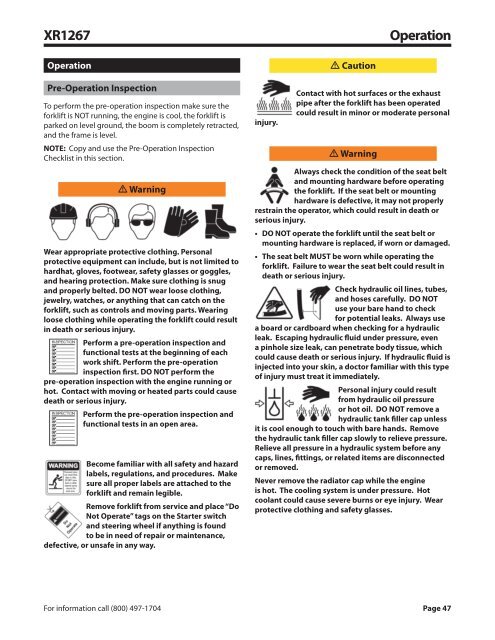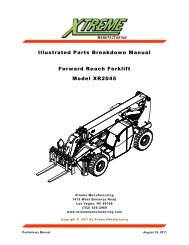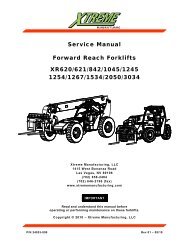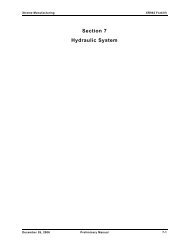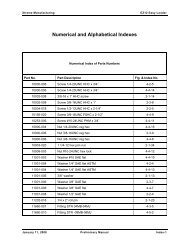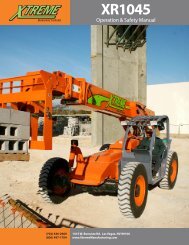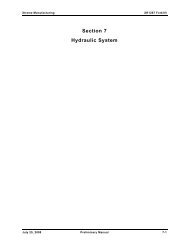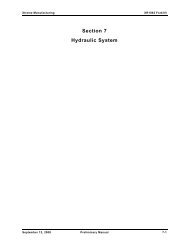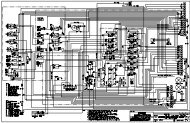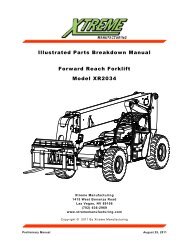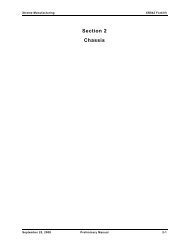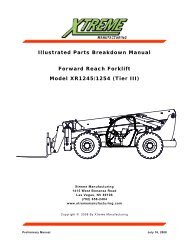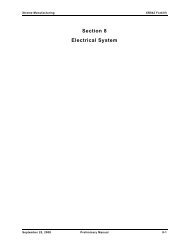XR1267 - Xtreme Manufacturing
XR1267 - Xtreme Manufacturing
XR1267 - Xtreme Manufacturing
Create successful ePaper yourself
Turn your PDF publications into a flip-book with our unique Google optimized e-Paper software.
<strong>XR1267</strong><br />
Operation<br />
Operation<br />
Pre-Operation Inspection<br />
To perform the pre-operation inspection make sure the<br />
forklift is NOT running, the engine is cool, the forklift is<br />
parked on level ground, the boom is completely retracted,<br />
and the frame is level.<br />
NOTE: Copy and use the Pre-Operation Inspection<br />
Checklist in this section.<br />
Warning<br />
Wear appropriate protective clothing. Personal<br />
protective equipment can include, but is not limited to<br />
hardhat, gloves, footwear, safety glasses or goggles,<br />
and hearing protection. Make sure clothing is snug<br />
and properly belted. DO NOT wear loose clothing,<br />
jewelry, watches, or anything that can catch on the<br />
forklift, such as controls and moving parts. Wearing<br />
loose clothing while operating the forklift could result<br />
in death or serious injury.<br />
Perform a pre-operation inspection and<br />
functional tests at the beginning of each<br />
work shift. Perform the pre-operation<br />
inspection first. DO NOT perform the<br />
pre-operation inspection with the engine running or<br />
hot. Contact with moving or heated parts could cause<br />
death or serious injury.<br />
Perform the pre-operation inspection and<br />
functional tests in an open area.<br />
Become familiar with all safety and hazard<br />
labels, regulations, and procedures. Make<br />
sure all proper labels are attached to the<br />
forklift and remain legible.<br />
Remove forklift from service and place “Do<br />
Not Operate” tags on the Starter switch<br />
and steering wheel if anything is found<br />
to be in need of repair or maintenance,<br />
defective, or unsafe in any way.<br />
injury.<br />
Caution<br />
Contact with hot surfaces or the exhaust<br />
pipe after the forklift has been operated<br />
could result in minor or moderate personal<br />
Warning<br />
Always check the condition of the seat belt<br />
and mounting hardware before operating<br />
the forklift. If the seat belt or mounting<br />
hardware is defective, it may not properly<br />
restrain the operator, which could result in death or<br />
serious injury.<br />
• DO NOT operate the forklift until the seat belt or<br />
mounting hardware is replaced, if worn or damaged.<br />
• The seat belt MUST be worn while operating the<br />
forklift. Failure to wear the seat belt could result in<br />
death or serious injury.<br />
Check hydraulic oil lines, tubes,<br />
and hoses carefully. DO NOT<br />
use your bare hand to check<br />
for potential leaks. Always use<br />
a board or cardboard when checking for a hydraulic<br />
leak. Escaping hydraulic fluid under pressure, even<br />
a pinhole size leak, can penetrate body tissue, which<br />
could cause death or serious injury. If hydraulic fluid is<br />
injected into your skin, a doctor familiar with this type<br />
of injury must treat it immediately.<br />
Personal injury could result<br />
from hydraulic oil pressure<br />
or hot oil. DO NOT remove a<br />
hydraulic tank filler cap unless<br />
it is cool enough to touch with bare hands. Remove<br />
the hydraulic tank filler cap slowly to relieve pressure.<br />
Relieve all pressure in a hydraulic system before any<br />
caps, lines, fittings, or related items are disconnected<br />
or removed.<br />
Never remove the radiator cap while the engine<br />
is hot. The cooling system is under pressure. Hot<br />
coolant could cause severe burns or eye injury. Wear<br />
protective clothing and safety glasses.<br />
For information call (800) 497-1704 Page 47


